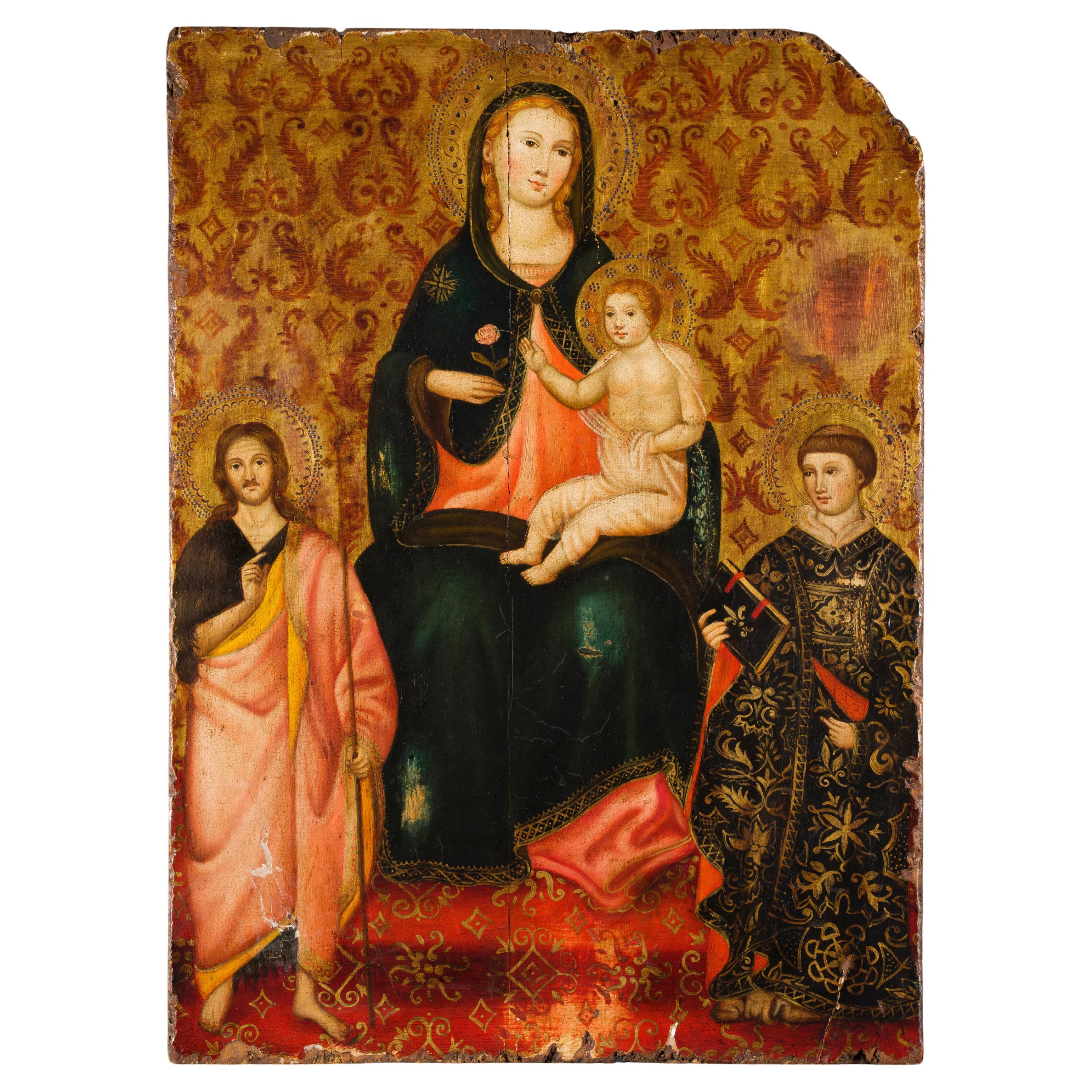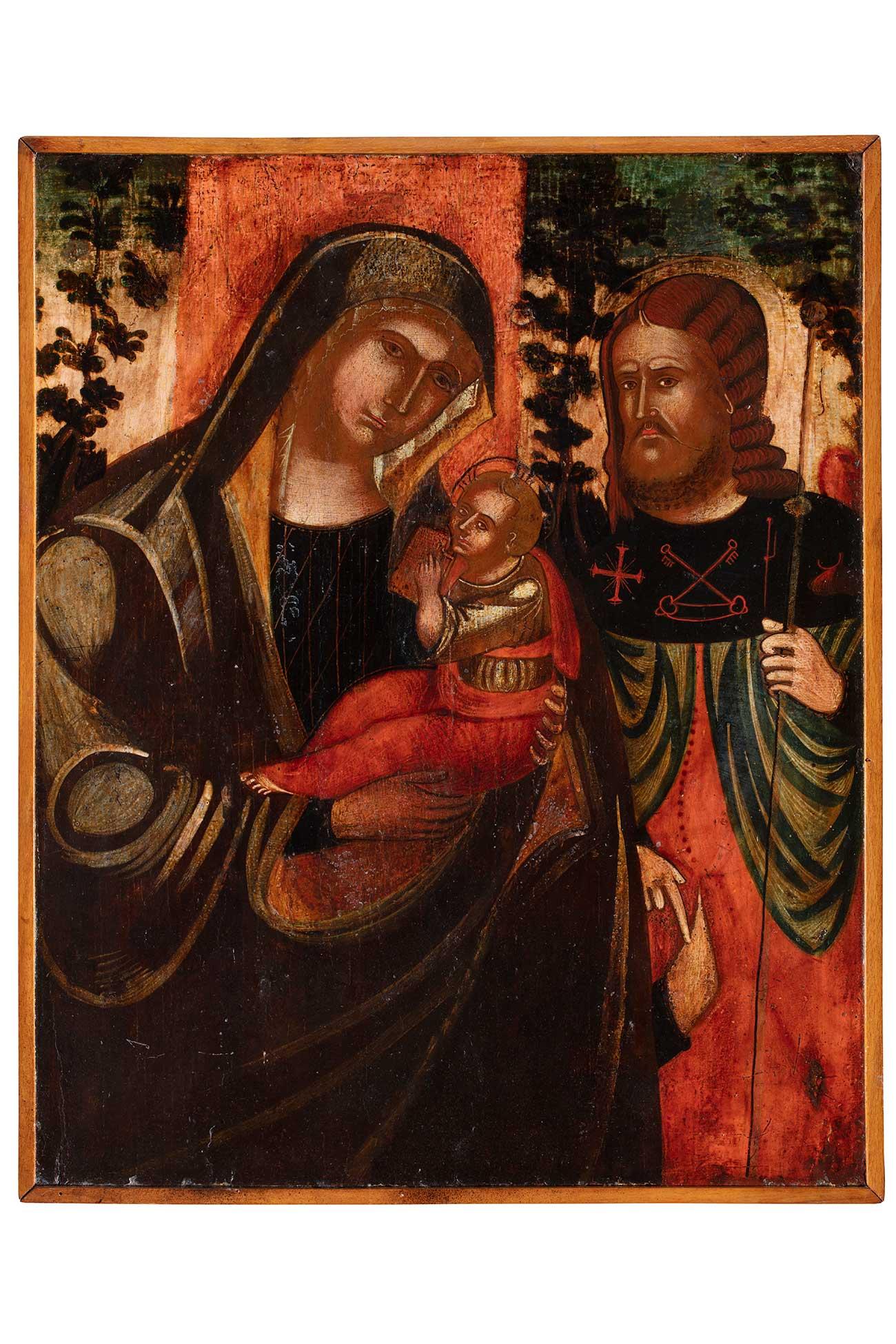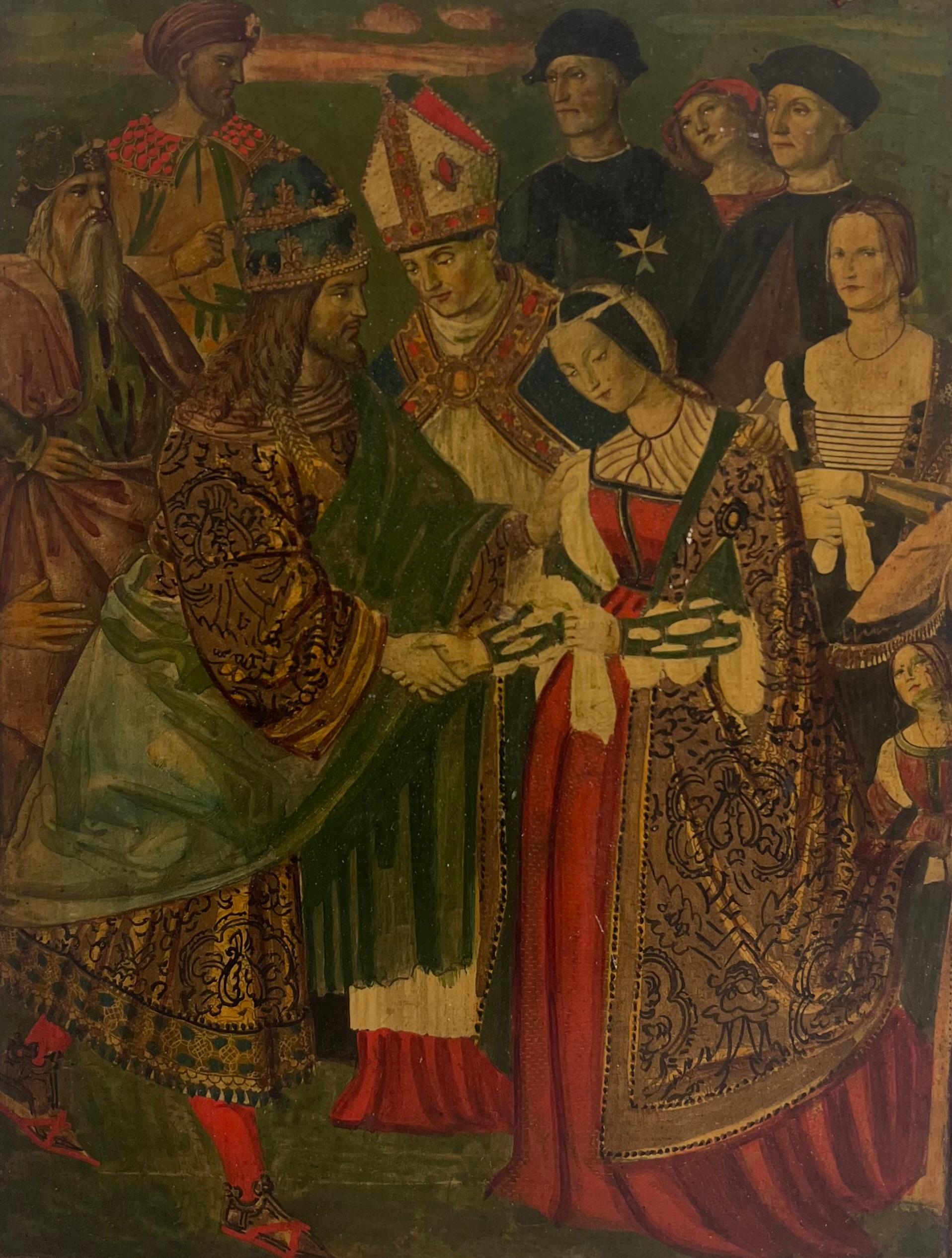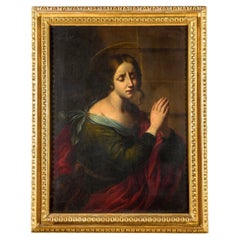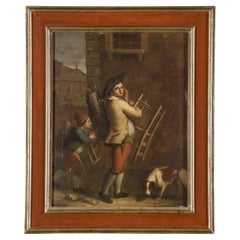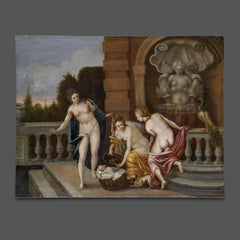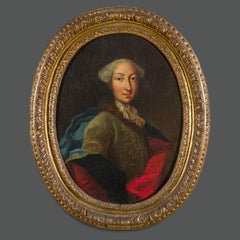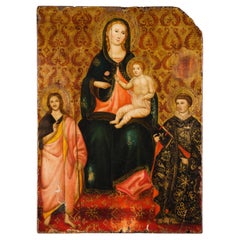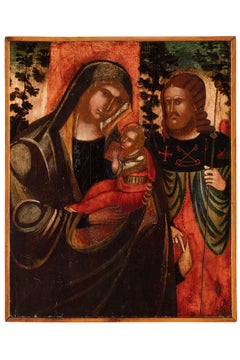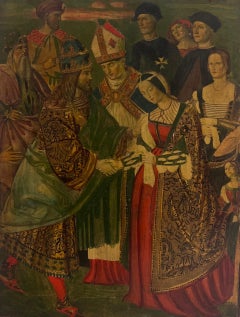Items Similar to Expertised Italian 14th Century Gold Ground on Panel Painting
Want more images or videos?
Request additional images or videos from the seller
1 of 24
Smeraldo Di GiovanniExpertised Italian 14th Century Gold Ground on Panel Painting1420 ca.
1420 ca.
$45,727.18
£33,854.25
€38,000
CA$63,312.48
A$69,122.07
CHF 36,237.87
MX$839,514.13
NOK 452,552.02
SEK 427,329.78
DKK 289,302.12
About the Item
Museum-quality gold ground painting from the Renaissance period by Smeraldo di Giovanni.
It depicts the “Virgin of the Roses” seated on a throne holding the Child Jesus.
Of Florentine manufacture, it shows at the sides the two patron saints of Florence, San Lorenzo and San Giovanni Battista.
Smeraldo di Giovanni (1365–1444) was an Italian painter of the late-Gothic through early-Renaissance period, active in Florence.
He worked with Ambrogio Baldese in Orsanmichele in 1402.
He is known to have been active in 1420, when he presumably worked in the same studio as Giovanni Dal Ponte (1385- c. 1438; thought to be the same person as Giovanni di Marco).
The Scali chapel of Santa Trinita in Florence has a fresco cycle by Giovanni dal Ponte and Smeraldo di Giovanni.
This artwork, not signed as usually in Gothic paintings and never before on the market, comes from an important Italian private collection.
Every item of our Gallery, upon request, is accompanied by a certificate of authenticity issued by Sabrina Egidi official Expert in Italian furniture for the Chamber of Commerce of Rome and for the Rome Civil Courts.
The following is the technical-historical record compiled by one of Italy's leading contemporary art historians: Claudio Strinati
" The Madonna of the Rose with Child Enthroned between Saints John the Baptist and Lawrence (tempera and oil on panel, 65 x 48 cm.) is a work of considerable value and formal preciousness, characterised by certain elements that lead one to date the work between the end of the 14th and the beginning of the 15th century.
The beautiful brocaded fabric that forms the background to the work and the refined carpet at the feet of the Virgin and the Saints give the sacred painting that secular and, one might say, bourgeois air of a home interior, according to a style that spread a little in all Italian painting traditions at the time, from Piedmont to Lombardy, from Tuscany to the Marches and so on.
Here, in our painting, the characters also have another characteristic typical of that time: the youthful and almost boyish appearance as if they were innocent and gentle children who have taken on the solemn identity of sacred figures.
Another characteristic typical of the time is the depiction of the child on the Virgin's lap completely naked from the navel up.
An atmosphere, in short, familiar and smiling.
Stylistically, our painting would seem to be part of the Tuscan tradition (also in relation to the saints represented and the image of the lily that stands out on the book of St. Lawrence) but with some interesting and problematic references also to the Veneto-Lombard tradition that includes giant personalities of strong influence such as Gentile da Fabriano or the Zavattari family or, in a broader sense, the painters and miniaturists gravitating around the immense construction site of Milan Cathedral and Monza Cathedral with echoes of Giovannino de' Grassi, Benedetto and Bonifacio Bembo, even the numerous and imaginative tarot painters.
It remains, however, that the panel under examination here would seem to fall more coherently within the Tuscan culture with references both to the milieu of the great illuminators such as Don Silvestro de' Gherarducci, and the monumental painters such as Orcagna and the learned Rossello di Jacopo Franchi, Niccolò di Pietro Gerini, Ambrogio di Baldese, and Ventura di Moro.
However, none of these painters, who have strong affinities with our panel, seems to me to be the author of the painting under examination here and, more generally, it seems very difficult to trace the same hand in works of certain attribution or signed in the Tuscan environment datable between 1390 and 1415/20, which I believe to be the period in which our painting was executed.
The only comparison known to me that is a little more stringent seems to be the one that can be established with the worn frescoes in the Scali Chapel in the Church of Santa Trinita in Florence, which fairly reliable sources refer to two remarkable painters of the time and of the same circle just mentioned, Giovanni dal Ponte and Smeraldo di Giovanni.
The latter, today little known (he was born around 1365 and died at the beginning of the fifth decade of the 15th century) could be our painter himself, with his enchanted and familiar tone at the same time, tending towards a description of happy and smiling characters, defined by a rounded and delicately full-bodied manner, perfectly consistent with a dating of the work to the second decade of the 15th century.
The state of preservation is very good, the evident damage being only marginal.
Very interesting is the refined drafting, where it is my impression that the traditional technique of egg tempera and oil tempera are co-present, giving the context precisely that preciousness and delicacy that arises almost naturally from such a technical combination, according to the recent (for the time) teachings of Cennino Cennini.
Moreover, his celebrated Libro dell' Arte was written (it seems in Padua) at the very end of the 14th century and circulated with particular prominence in exactly the same years in which I believe our painting was executed.
A painting, therefore, of remarkable quality and of even greater historical/critical interest."
Claudio Strinati
Under existing legislation, any artwork created over 70 years ago by an artist who has died can requires a license for export regardless of the work’s market price. The shipping may require additional handling days to require the license according to the destination of the artwork.
- Creator:Smeraldo Di Giovanni (1365 - 1444, Italian)
- Creation Year:1420 ca.
- Dimensions:Height: 25.6 in (65 cm)Width: 18.9 in (48 cm)Depth: 2.76 in (7 cm)
- Medium:
- Movement & Style:
- Period:
- Condition:The painting is in its magnificent original patina. In excellent overall condition. There are some defects in non-critical areas of the panel, which we have chosen not to touch in order to preserve the originality of this museum-quality painting as m.
- Gallery Location:Roma, IT
- Reference Number:1stDibs: LU2883216513342
About the Seller
New to 1stDibs
Joined in the past six months.
No Reviews Yet
Vetted Professional Seller
Every seller passes strict standards for authenticity and reliability
Established in 1990
1stDibs seller since 2025
- ShippingRetrieving quote...Shipping from: Roma, Italy
- Return Policy
Authenticity Guarantee
In the unlikely event there’s an issue with an item’s authenticity, contact us within 1 year for a full refund. DetailsMoney-Back Guarantee
If your item is not as described, is damaged in transit, or does not arrive, contact us within 7 days for a full refund. Details24-Hour Cancellation
You have a 24-hour grace period in which to reconsider your purchase, with no questions asked.Vetted Professional Sellers
Our world-class sellers must adhere to strict standards for service and quality, maintaining the integrity of our listings.Price-Match Guarantee
If you find that a seller listed the same item for a lower price elsewhere, we’ll match it.Trusted Global Delivery
Our best-in-class carrier network provides specialized shipping options worldwide, including custom delivery.More From This Seller
View All17th Century Onorio Marinari Italian Religious Painting
By Onorio Marinari
Located in Roma, IT
A very important painting by the great artist of the Florentine school, Onorio Marinari.
Dr. Silvia Benassai has confirmed Marinari’s authorship of the Saint Margaret of Antioch; ava...
Category
Mid-17th Century Baroque Portrait Paintings
Materials
Canvas, Oil
Period Italian Venetian Portrait Painting
By Francesco Fedeli
Located in Roma, IT
Francesco Fedeli (Venice, 1738 - 1805) called “Il Maggiotto “ great Italian painter and physicist.
The “𝗖𝗼𝗻𝗰𝗶𝗮 𝗖𝗮𝗿𝗲𝗴𝗵𝗲” ( Craftsman fixing chairs ) is taken from one of...
Category
Late 18th Century Old Masters Portrait Paintings
Materials
Canvas, Oil
Francesco Albani Circle Italian Mythological Painting
Located in Roma, IT
Francesco Albani Circle Italian Mythological Painting
This important oil painting on wood depicts a subject that is very rare in the iconography of ancient mythological paintings: the birth of Erittonio. Erichthonius who succeeded Amphictyon becoming the fourth mythological king of Athens and married the naiad Praxithea who made him the father of Pandion.
The extremely high quality of this very rare painting suggests that it was painted by an artist who frequented Francesco Albani's studio.
The period, the mythological subject, the harmony of the colours and, above all, the sublime quality of the flesh tones all point in this direction.
This artwork, never before on the market, comes from an important Italian private collection
Every item of our Gallery, upon request, is accompanied by a certificate of authenticity issued by Sabrina Egidi official Expert in Italian furniture for the Chamber of Commerce of Rome and for the Rome Civil Courts.
ERYTHTONIOS (᾿Ερυχϑόνιος, Erychthonios)
Born of Hephaestus' love for Athena, from the breast of Ghe, who was impregnated by the god; welcomed by Athena, who placed him in a basket together with one or two snakes, entrusting him to the care of Cecrops' three daughters.
Against the goddess's wishes, they opened the chest, from which emerged, according to different versions of the myth, either the child wrapped in snakes or a snake, which, in some versions, killed the girls, while in others, they threw themselves from the Acropolis in fear. Erittonio, in the form of a snake, is welcomed by Athena into her temple and curls up under the goddess's shield. Alongside this myth, of Ionian origin, are others due to the doubling of the figures of E. and Erechtheus
The scene of the birth appears in figurative tradition: in a Melian terracotta relief from the early 5th century, Ghe, half-emerging, holds out the baby Erittonio. to Athena, who welcomes him in the presence of Cecrops; the same scene appears on various painted vases, such as a red-figure kölix by the Painter of Kodros, from Tarquinia, in the Berlin Museums, dating from around 440 BC, where Hephaestus also appears alongside Cecrops.
A modest red-figure vase from Camiro, in the British Museum, depicts the moment when the fleeing Cecropids discover the cista, from which the infant Erittonio. emerges between two snakes, greeting Athena.
The moment when the chest was opened was depicted by Phidias on the xiii and xiv S metopes of the Parthenon, where Cecrops and Pandrosus appear in the first and Erisichthon and Aglaurus with the chest uncovered in the second.
A kölix in the style of the Brygos Painter in Frankfurt, on the other hand, depicts the large snake E. chasing the fleeing Cecropids towards their father's palace.
Luciano (De dom., 27) recalls a painting depicting the scene of the birth and the representation of the myth in pantomime on the theatre (De salt., 39).
Bibliography: Engelmann, in Roscher, cc. 1303-1308, s. v. Erichthonios; P. Jacobstahl, Die Melischen Reliefs, Berlin 1931, pp. 96-98, plate 75 a; W. Züchner, in Jahrbuch, LXV-LXVI, 1950-51, p. 200 ff., figs. 34-35; J. D. Beazley, Red-fig., p. 720; G. Becatti, Problemi fidiaci, Florence 1951, p. 22.
Questo
Francesco Albani (Bologna, August 17, 1578 – Bologna, October 4, 1660) was an Italian painter.
Albani was born in Bologna, Papal States, in 1578.
His father was a silk merchant who intended his son to go into his own trade. By the age of twelve, however, he had become an apprentice to the competent mannerist painter Denis Calvaert, in whose studio he met Guido Reni. He soon followed Reni to the so-called "Academy" run by Annibale, Agostino, and Ludovico Carracci.
This studio fostered the careers of many painters of the Bolognese school, including Domenichino, Massari, Viola, Lanfranco, Giovanni Francesco Grimaldi...
Category
Late 17th Century Old Masters Figurative Paintings
Materials
Oil, Wood Panel
18th Century Italian Portrait Credited to Maria Giovanna Battista Clementi
Located in Roma, IT
18th Century Italian Portrait Credited to Maria Giovanna Battista Clementi
The painting probably depicts a young nobleman of Savoy court and is characterized by its courtly setting. ...
Category
Mid-18th Century Old Masters Portrait Paintings
Materials
Oil, Canvas
19th Century Cesare Ciani Credited Italian Macchiaiolo Painting
By Cesare Ciani
Located in Roma, IT
19th Century Cesare Ciani Credited Italian Macchiaiolo Painting
A beautiful, intense painting attributed to the great Macchiaioli painter Cesare Ciani.
It depicts with rare realism ...
Category
Late 19th Century Italian School Portrait Paintings
Materials
Oil, Wood Panel
18th Century French Rococò Painting
By Jean Raoux
Located in Roma, IT
18th Century French Rococò Painting
An oil on panel painting attributed to the great French artist of the eighth century, Jean Ra...
Category
Early 18th Century Rococo Portrait Paintings
Materials
Wood, Canvas, Oil
You May Also Like
Expertised Italian 14th Century Gold Ground on Panel Painting
Located in Roma, IT
Important tempera and gold ground on panel, museum painting Florentin “Fondo Oro”.
Produced in Florence in the second half of the 14th century by the great Florentine artist Smerald...
Category
Antique 15th Century and Earlier Italian Renaissance Paintings
Materials
Wood
15th Century by Circle of Nicolò Zafuri Madonna with Child Oil on Canvas
Located in Milano, Lombardia
Nicolò Zafuri (circle of) (documented in Candia between 1487 and 1500, died before 10 July 1501)
Title: Madonna with Child
Medium: Oil on panel
Dimensions: without frame 49 x 40 cm
...
Category
15th Century and Earlier Old Masters Portrait Paintings
Materials
Cotton, Cotton Canvas, Oil
$13,236 Sale Price
20% Off
Madonna Maria Sassoferrato Paint Oil on canvas Old master 18th Century Italian
Located in Riva del Garda, IT
Madonna with Sleeping Child
Follower of Giovan Battista Salvi known as 'il Sassoferrato' (1609 - 1685)
Roman painter 18th century
Oil on canvas
Measurements: canvas 64 x 50 cm, in frame 76 x 62 cm.
This delicate depiction of the Madonna in adoration of the Child exhibits all the human dimension and sweetness of the maternal atmosphere: Mary clasps the sleeping child to her in a tender embrace, which touches her cheek, enveloped and protected by the mantle and even a flap of the mother's veil.
The pictorial style and composition recall the ambit of Giovan Battista Salvi, the Sassoferrato, who distinguished himself expressly for this subject, with the Virgin immortalised in a humble and strongly earthly pose, depicted with simple white, red and blue colours and delicate plays of nuances on the faces and hands.
This iconographic prototype was so successful that it became the painting for countless works destined for devotion during the 17th and 18th centuries, particularly appreciated for private commissions due to its marked gentleness and formal perfection, particularly of the faces.
Born in Marchigiano, Salvi developed his activity in Rome, following the dictates of the classicist sacred painting of the Bolognese school of Reni, Carracci and Domenichino, but succeeding in having an autonomous and therefore clearly distinguishable style.
In very good overall condition, there are some small scattered restorations and some unravelling of the painted surface. Framed in a beautiful gilded frame.
ADDITIONAL INFORMATION:
The work is sold with a certificate of authenticity and descriptive iconographic card.
We take care of and organise the transport of the purchased works, both for Italy and abroad, through professional and insured carriers.
It is also possible to see the painting in the gallery in Riva del Garda...
Category
18th Century Old Masters Paintings
Materials
Oil
$4,129 Sale Price
20% Off
Antique Italian Renaissance Old Master Painting Eleonora of Portugal Frederick 3
Located in Cirencester, Gloucestershire
"Aeneas Piccolomini Introduces Eleonora of Portugal to Frederick III"
Siena School, late 19th century
After Bernardino Di Betto (Pintoricchio) 1454-1513
painting on wood panel, unfra...
Category
Late 19th Century Renaissance Figurative Paintings
Materials
Oil
Museum Quality Renaissance Masterpiece Virgin Mary & Infant Christ painting
Located in Cirencester, Gloucestershire
The Virgin Mary holding the infant Jesus
Italian 17th century
oil on copper, in tabernacle frame
Overall framed: 19 x 17 inches
Actual copper panel: 14.25 x 11 inches
Provenance: pr...
Category
17th Century Byzantine Figurative Paintings
Materials
Copper
Madonna Lactans , Gold Background , Quattrocento Attributed to Sano di Pietro
Located in PARIS, FR
-Madonna Lactans, Gold Background Quattrocento
Our painting is on poplar wood, characteristic of Italian Quattrocento works.
The gold background is stuccoed and engraved.
Our Madonna Lactans is a variation on the theme of the Madonna and Child.
In Christian iconography, this subject is depicted at a moment of great intimacy, as the Virgin Mary delicately takes Christ's foot.
When cleaning the work, small jets of milk can be seen ...
Sano di Pietro...
Category
Antique 15th Century and Earlier Italian Renaissance Paintings
Materials
Wood
More Ways To Browse
15th Century Italian
Wood Panel Italian
Italian Renaissance Art
Italian Renaissance Painting
Renaissance Panel
Early Renaissance Art
Tempera On Wood
Renaissance Wood Panels
Italian Renaissance 15th Century
Antique Brocade Fabric
15th Century Panels
Painting 14th Century
Antique Moro
15th Century Italian Painting
Gold Ground Painting
Girl Horse Painting
Grosso Giacomo
Guirand De Scevola
